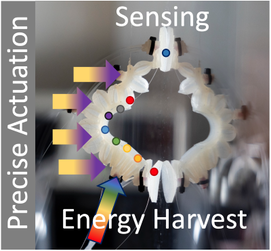Teaming for Interdisciplinary Research Pre-Seed Program
Rainbow-Inspired Soft Robotic with Embedded Light Actuators and Nerve System

Rainbow-Inspired Soft Robotic with Embedded Light Actuators and Nerve System

LightBot – Rainbow-Inspired Soft Robotic with Embedded Light Actuators and Nerve System
Baymax from Disney movie Hero 6 brought out the idea that robots do not have to be rigid and hard. Robots could be like living organisms that are flexible and soft. Soft robots is a promising candidate that can provide a safe and gentle mechanical interaction with surrounding environments that are unmatched by conventional robots. New techniques to precisely control soft robots would positively impact the productivity and safety of our society. Imagine, if surgical robots can perform surgery with human-like precision and a delicate touch. Also, humans can work collaboratively with soft robots without worrying about further injury. Soft rescue robots can squeeze through debris in a disaster without causing explosion or structural collapse. All of these could be possible if the light-actuated soft robot with high-precision embedded control, real-time sensing and feedback would exist.
However, the development of soft robots is very limited – coarse pneumatic control, tethered electrical control, and lack of sensing. Therefore, we propose to look at the problem from the perspective of six distinct disciplines that use complementary techniques to analyze and solve the material, energy delivery, actuation, sensing, and modeling challenge of soft robotics. Our overall goal is to create autonomous soft robotic with multiple embedded color-based fast actuation mechanisms and real-time sensing feedbacks. Multidisciplinary collaboration allows us to fuse together techniques that have not been explored before to harvest light, use color-selective light actuation, infuse novel nanoparticles in new soft materials for fast and effective actuation, and reuse the light for sensing. Each of the six team members brings distinct expertise that is tied together by the associate of material response and light interaction:
- Mable Fok is an expert in fiber optics, sensing, and soft robotic design. She will utilize her experience on light manipulation and delivery, as well as soft robot design spectral control of precise soft robotic movements.
- Jason Locklin is an expert in polymer materials science. He is developing thermoplastics and other materials that are bio based. He will utilize his extensive experience in selecting soft materials properties, and interfacial engineering and sensing to design the responsive material for the soft robot.
- Vladimir Popik is an expert in synthesizing photo-reactive molecules, photo switches, as well as in derivatization of polymers with photo-reactive moieties. He will use his experience in photo-reactive molecules for selection, optimization, and testing of photo-switches for the design of the soft robot.
- Xianqiao Wang is an expert in computational mechanics, soft matter mechanics, and material design by artificial intelligent. He will bring his computational modeling and materials design experience into the LightBot project, help optimize the design, and validate the experimental observation with simulation data.
- Jin Xie is an expert in nanoparticle synthesis and surface engineering, photodynamic therapy, radiotherapy, bio imaging, and drug delivery. He will be designing inorganic nanoparticle synthesis and investigate surface chemistry in the soft robot.
- Yiping Zhao is an expert in nanofabrication, nanomotors, photocatalyst design, and biosensors. He is currently working on magnetic nanomotors and understanding the charge dynamics of photocatalyst. He will use his nanomaterial experience on nanomotors to design an effective light to actuator interface.
Our team’s overall goal is to investigate the design of new soft responsive materials through the infusion of novel nanoparticle as well as embedded light delivery to enable fast and precise light-actuated soft robots. The TIR funding will be used to brainstorm and discuss ideas that will culminate in the applications of various discipline grants, including NSF Materials Research, NSF Research in Robotics, NASA Science Mission, US Navy.
Team Leader
Mable Fok
mfok@uga.edu
College: College of Engineering
Department: Electrical and Computer Engineering
Team Members
Vladimir Popik
vpopik@uga.edu
College: Franklin College of Arts and Sciences
Department: Department of Chemistry
Xianqiao Wang
xqwang@uga.edu
College: College of Engineering
Department: School of Environmental, Civil, Agricultural, and Mechanical Engineering
Jin Xie
jinxie@uga.edu
College: Franklin College of Arts and Sciences
Department: Department of Chemistry
Yiping Zhao
zhaoy@uga.edu
College: Franklin College of Arts and Sciences
Department: Department of Physics and Astronomy
Jason Locklin
jlocklin@uga.edu
College: College of Engineering
Department: School of Chemical, Materials, and Biomedical Engineering
